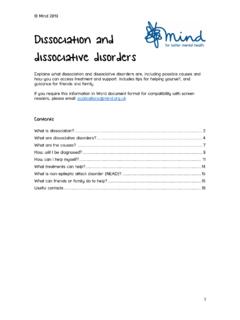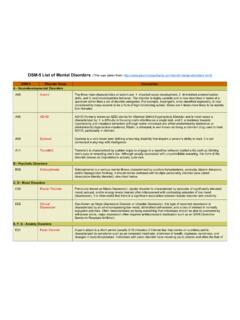Transcription of Integrative Research Paper: Dissociative Identity Disorder
1 Dissociative Identity Disorder 1 Integrative Research paper : Dissociative Identity Disorder Tom Schmidt Abnormal Psychology 3141 Doctor Marleen Smith 29 November 2007 Dissociative Identity Disorder 2 Integrative Research paper : Dissociative Identity Disorder Few psychological disorders in the Diagnostic Statistical Manual have generated as much controversy as Dissociative Identity Disorder (DID). For the past 35 years diagnoses of DID, previously referred to as multiple personality Disorder (MPD), have increased exponentially, causing various psychological researchers and clinicians to question the validity of this Disorder . DID is, however, currently recognized by the DSM-IV-TR as a true psychological Disorder that emerges, most commonly, as a result of early childhood sexual abuse (DSM-IV-TR, 1994; Haddock, 2001; Zimbardo, Johnson, & Weber, 2006; Comer, 2007; Lev-Wiesel, 2005). In this essay I will first provide background information on DID, and identify and define the terminology commonly associated with the Disorder .
2 Second, I will discuss treatment modality, in addition to options for health insurance coverage. Third, I will discuss the argument of Dr. August Piper and Harold Merskey that contradicts the validity of DID. And lastly, I will address the ethical importance of recognizing DID as a severe and complicated Disorder that continues to defy a mechanistic definition. Background Evidence for Dissociative Identity Disorder dates back to the Paleolithic era, however, it was not until the late eighteenth century that recorded cases of exchanged personalities began to emerge (as cited in Cohen, Berzoff, & Elin, 1995, p. 28). In 1791, a 20-year-old woman from southern Germany adopted the personality of a French aristocrat and even began speaking fluent French. The woman seemingly developed two Dissociative Identity Disorder 3 different nationalistic personalities (French and German) that, when told of the other, denied any recollection or awareness of it.
3 More recently, the case of Sybil Isabel Dorsett has come to be considered the most important clinical case of multiple personality which linked the Disorder to early childhood abuse (as cited in Cohen et al., 1995, p. 362; Lev-Wiesel, 2005). Combined, Sybil developed sixteen different personalities all of which she was unaware of to help her cope with the emotional trauma that was caused by early childhood abuse. Sybil s case was important for the understanding and early acceptance of DID because it gave psychologists a standard measure with which to assess and diagnose other people showing similar symptoms. By 1980 the criteria for diagnosing MPD became solidified in the publication of the DSM-III. In 1994, MPD was renamed Dissociative Identity Disorder and an increasing amount of information concerning assessment and diagnosis was made available to clinicians and therapists (as cited in Cohen et al., 1995, p. 353). Although DID is widely accepted as a true psychological Disorder , clinicians such as Piper and Merskey (2004) maintain that it is an illegitimate construct that is imposed upon the patient, by the therapist (p.)
4 676). Currently DID is defined as the presence of two or more distinct identities or personality states that recurrently take control of the individual s behavior, accompanied by an inability to recall important personal information that is too extensive to be explained by ordinary Disorder characterized by Identity fragmentation rather than a proliferation of separate personalities (DSM-IV-TR, 1994, p. 528; Zimbardo et al., 2006, p. 504; Comer, 2007, p. 208). The Identity of the dominant, or host personality , breaks off sub categorically, and identities begin to develop with Dissociative Identity Disorder 4 separate and distinct sets of memories, behavioral patterns, historical and familial backgrounds, differing physiological characteristics, and cognitive function (Comer, 2007, p. 208). Comer (2007) refers to the separate and distinct personalities of the individual as sub personalities or alternate personalities (p. 208).
5 The transference from one Identity to the next is referred to as switching, commonly triggered by a negative or stressful event or experience although, at times, occurring without noticeable indication (Comer, 2007, p. 208; Thomas, ). Interaction between the sub personalities can vary greatly, however, there are three primary relationships that commonly develop. One, mutually amnesic relationships are defined as personalities that have no awareness of the others. Two, the mutually cognizant pattern is defined as the sub personalities being aware and in-tune with the other personalities, often having discussions with one another. And three, one-way amnesic relationships in which various sub personalities are aware of the others, yet, some personalities maintain no connection or awareness of the others (as cited in Comer, 2007, p. 209). Causes of DID From the psychodynamic perspective DID is generally recognized as a developmental Disorder that emerges due to early childhood sexual abuse or trauma (Haddock, 2001; Zimbardo et al.)
6 , 2006; Comer, 2007; Lev-Wiesel, 2005). The dissociation from one's true self is essentially a coping mechanism to protect the individual from fearful emotions or situations. As Haddock (2001) demonstrates, "if an individual is traumatized in early childhood and the experience is so overwhelming that he is unable to process it, the child may dissociate to survive" (p. 28). What separates the Dissociative Identity Disorder 5 severe form of dissociation from normal, everyday dissociation, such as daydreaming, is the brains biological response to overwhelming and extended experiences with traumatic stimuli. Because most cases of DID are linked to early childhood abuse, experienced at age nine or before (Lev-Wiesel, 2005), it is easy to understand how an individual finds solace in dissociating from their dominant personality by allowing sub personalities to emerge and confront difficult situations or emotions. From the behavioral perspective DID is understood as the result of a cyclical method of dissociation from everyday memory processes learned over time (Comer, 2007, p.
7 211). More simply, the individual learns through operant conditioning that "reinforced acts of them escape anxiety" (Comer, p. 211). Over time, an individuals learned "escapist behavior" causes them to dissociate more often, and to a greater degree of intensity from their dominant personality . It is important to note that DID is not recognized as a psychotic Disorder , commonly mis-referred to as a split personality Disorder (Zimbardo et al., 2006, p. 505). Additionally, it is important to note the difference between DID and post traumatic stress Disorder (PTSD), as DID closely resembles, and is often misdiagnosed as PTSD. DID is an organization of negative emotions that are assigned to different sub personalities (Haddock, 2001, p. 30). While DID can be involuntary acts of mental escape in order to help alleviate negative emotions, PTSD is a more direct, and voluntary form of emotional repression. Diagnosing DID As mentioned previously, the DSM-IV-TR has outlined the criterion for DID to be accurately diagnosed.
8 Despite new techniques for diagnosing and treating DID, the Dissociative Identity Disorder 6 Disorder remains relatively elusive to detection in early childhood (Lev-Wiesel, 2005). The symptoms of DID closely resemble the symptoms of other disorders , such as, "attention deficit Disorder , oppositional or conduct disorders , anxiety and panic disorders , post traumatic stress disorders , depression and suicidal ideation, and substance abuse," making the Disorder difficult to diagnose (Lev-Wiesel, 2005). Unfortunately, many individuals suffering from DID spend a great deal of their time in search of relief prior to receiving an accurate diagnosis (Petersen, 2003, p. 1; Lev-Wiesel, 2005). Nevertheless, it is important to recognize the primary symptoms of DID prior to discussing treatment modality. Dr. Gary Peterson (2003) of the University of South Florida outlines five of the primary Dissociative symptoms that are indicative of DID. First, "inconsistent consciousness may be reflected in symptoms of fluctuating attention, such as trance states or 'black outs'" (p.)
9 2). Second, "autobiographical forgetfulness and fluctuations in access to knowledge" may be indicative of a disruption in memory processes in early childhood development (p. 2). Third, "fluctuating moods and reflect difficulties in self-regulation" (p. 2). Fourth, a "belief in alternate selves or imaginary reflect disorganization in the development of a cohesive self" (p. 2). And fifth, "depersonalization and derealization may reflect a subjective sense of dissociation from normal body sensation and perception" (p. 2). Peterson s model demonstrates how indications of detachment from the primary personality , and the emergence of sub personalities, contribute to a plausible diagnosis of DID. Dissociative Identity Disorder 7 Treatment Treatment through artistic expression is one method for both therapy and assessment of DID. Lev-Wiesel (2005) conducted a study based on a technique known as the Draw-A-Person (DAP) test "to examine to what extent Dissociative Identity Disorder is reflected in human figure drawings.
10 " In the study, Lev-Wiesel (2005) found that individuals who are diagnosed with DID "reveal their emotional states," by creating drawings that reflect the individuals' sub personalities. This is important for the therapist because it identifies the various sub personalities (that emerge in the drawings) which may be the first step towards, "establish(ing) a greater integration between" all personalities (Lev-Wiesel, 2005). The DAP is also an invaluable form of self-expression for an individual with DID because it creates an emotional and expressionistic outlet that may otherwise emerge, and switch to replace the dominant personality . Additionally, Lev-Wiesel's study demonstrates how the DAP test is beneficial for assessment of DID which, as mentioned previously, may be difficult. If an individual is issued the DAP test and their drawings reflect, "multiplicity or part of the whole seems worthwhile for clinicians to further inquire (about) the client's Dissociative mechanisms" (Lev-Wiesel, 2005).












